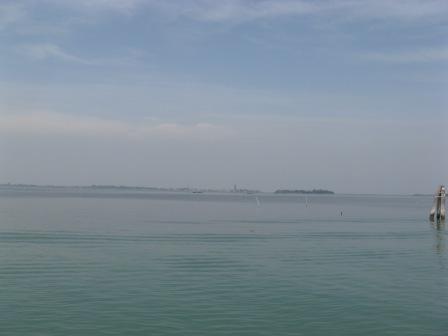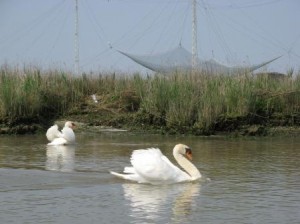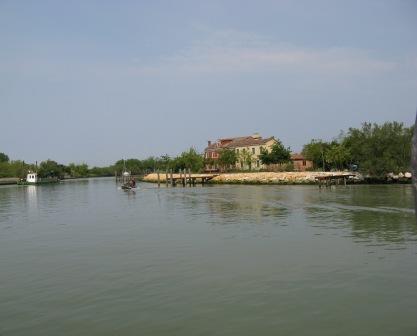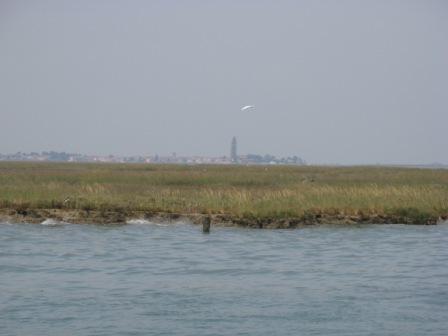“Every river is compelled to flow toward the sea, and it also carries tears with it.”
I don’t know who wrote that, but it is the perfect epigraph for the Po River. And nearly 60 years ago, there were many, many tears.
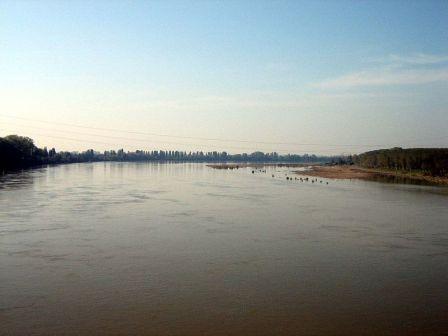
Those two words — Po River — are tremendously evocative to millions, especially those living near it, or in some way depending on it. It’s the longest river in Italy, and although it isn’t much compared to the Nile or the Congo, it is Italy’s mythic mass of water.
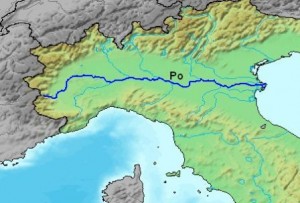
The Po flows 405 miles [652 kilometers] from Monviso, a dazzling mountain in the Cottian Alps, to the Adriatic, through the core of the north Italian Padania Plain and drains an area of 28,946 square miles [74,970 square kilometers].
Some people think it’s monotonous and boring, but that’s when it’s just rolling along like Ol’ Man River. Then every once in a while it floods, and turns into something cataclysmic, and suddenly people are praying to God to make it boring again. You can read more in the article I wrote for National Geographic in the May, 2002 issue.
I’m talking about all this because of my chronic curiosity about a statue stuck off by itself amid a few trees near the Giardini vaporetto stop.
It’s dramatic yet curiously detached; nevertheless, you realize something serious is underway. A rescue, obviously, but it isn’t immediately clear what the danger is. It’s the Po.
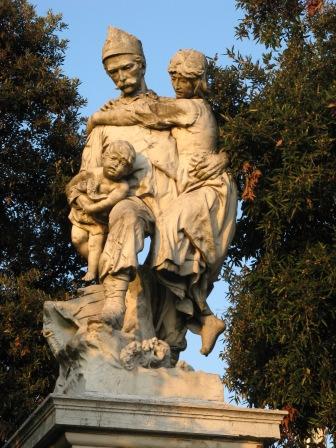
I’m not going to try to describe it; the numbers can do it for me. But I do remember what a friend of mine in Cremona told me about the Po in the major flood of 2000: “The river under the bridge sounded like a waterfall.” In 1951, the volume of water was measured at Cremona at 399,055 cubic feet per second [11,300 cubic meters per second] — it must have sounded like the Last Judgment.
That autumn was especially rainy, not only in Italy but elsewhere in Europe and also in the United States. From November 7-13, two weather fronts — one from the Atlantic, the other from Africa — brought rain that wasn’t particularly intense, but it was continuous. In fact, due to the nature and extent of the catchment basin, it’s long rains, rather than intense ones, that create serious floods.
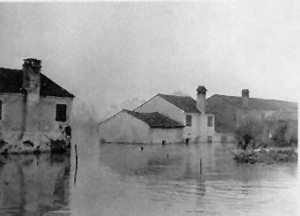
In the five days between November 8-12, 600 billion cubic feet [17 billion cubic meters] of water fell on the Po Plain, the amount which would normally fall in six months.
The Po’s average discharge is 48,400 cubic feet per second [1,370 cubic meters]; at its flood peak in 1951, the Po’s discharge was estimated at almost ten times that, or 424,000 cubic feet [12,000 cubit meters] per second. That would be Niagara Falls doubled, thundering horizontally toward the sea.
The river was rising because many of its 141 tributaries were also rising, obviously. But when some of these smaller rivers tried to empty into the Po, the power of its flow actually forced them back, where they began to flood their own immediate surrounding territory. That southeast wind wasn’t merely melting snow, it was preventing the Po from emptying into the sea.
Nov. 13: During the night, the church bells in Casalmaggiore (Cremona) and Sabbioneta (Mantova) and all the bells in the surrounding towns and villages begin to ring, to summon the men to try to block the rising water. Urgent requests go out for sandbags.
Nov. 14: The Po exceeds 14 feet [4.30 meters]. At 7:00 pm the river bursts its embankments at Paviole di Canaro. An hour later, it breaks through at Bosco and Malcantone at the rate of 211,883 cubic feet [6,000 cubic meters] of water per second. In a few hours 156 square miles [404 square kilometers] are flooded.
When the flood crest reaches the Po Delta, the area also called Polesine, the level is higher at Rovigo — 15.7 feet [4.8 meters] — than any recorded flood ever.
Nov. 15: An emergency truck evacuating people is caught by the water at Frassinelle Polesine; 84 people, including women and children, die in what is remembered as the “death lorry.”
At 2:00 pm the river bursts the banks at Arqua’ Polesine and the water spreads toward Adria.
Nov. 18: Rovigo is evacuated.
Nov. 19: Adria, Cavarzere, Loreo are completely flooded. The cities are evacuated.
Nov. 20: The embankments at Ceserolo are cut to save Rovigo.
Nov. 25: The crest reaches the sea, and the water begins to recede. After three months, toward the end of February, only about one third of the flooded land is still submerged.
In all, some 425 square miles [1,100 square kilometers] were flooded.
The rescue efforts were massive: The Army, Navy, Air Force, firemen, police, Red Cross, Scouts, and volunteers descended on the stricken towns, working continuously with the help of some 2,000 boatmen. People spent days trapped on the roofs of their isolated houses, hoping someone would come by.
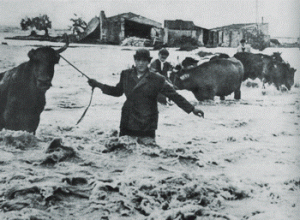
4500 cattle, 150 horses, 7800 pigs, 700 sheep and goats, and one million quintals [220 million pounds] of fodder, all lost.
37 miles [60 kilometers] of embankments and 52 bridges destroyed.
Of course no one had insurance. What was lost was gone forever. It was Biblical.
Contributions poured — excuse the expression — in, from 65 countries, including Uruguay, Tunisia, Haiti, Indonesia, Lebanon, Costa Rica, Somaliland (as it was known), and Albania, as well as NATO.
Lino remembers the effect it had on people in Venice who, like people for miles around, responded by bringing mattresses, clothes, shoes, blankets, and more to collection points around the city. My friend Roberto, from Milan, was just a tyke at the time, but he still remembers his mother telling him he had to donate one of his toys to the children in Polesine, and not just any toy. She decreed, “Your favorite toy.'”
“It was my favorite teddy bear,” he told me, “but I sent it away.”

Many improvements were attempted to prevent anything like this happening again. One of the measures taken was to build ever higher embankments, often (in the cities) walled with concrete. You know how water behaves when it’s forced into a tighter channel or tube? Think of turning on your faucet very hard. Yes. That’s what the Po does now when it floods.
Therefore, when the river floods in spring (melting snow) or autumn (rains), as it will do until snow and rain cease from the earth, it inevitably gains force as it races seaward.
So floods continue — not much anyone can do about that — but the effects are still, if not as catastrophic as in 1951, expensive and distressing. Because houses and fields and poplar forests planted for cellulose keep increasing, and always closer to the river’s edge.
Oh, and some 30 million cubic yards of sand and gravel are illegally dug out of the riverbed for construction every year. Not good if you were looking for ways to minimize flooding, which if you’re a gravel-robber you probably aren’t.
In 1994, the Po flood caused 70 deaths and 10,000 people lost their homes, due mainly to failures in the flood warning system. The human element — always the wild card.
In 2000, the Po flood caused 25 deaths and 40,000 were evacuated.
And so it goes. The Po. Majestic. Magnificent. But I’d never call it monotonous.
NOTE: About the statue with the double inscription: Everyone but me will already have figured it out — it was originally made to commemorate the heroic efforts of the Army to help the victims of the Po flood in the spring of 1882. (I know that the inscription reads 1885, but I am trusting my source, the immortal Giulio Lorenzetti, for this information.) After the inundation of 1951, the statue was recycled to commemorate the equally heroic rescue work (hence the noticeably non-1951 garb of the figures depicted).
Alberto Vio, Lino tells me, was “famous” for having provided boats for the rescue efforts. I don’t know any more than that just now, but it explains why he is mentioned on the plinth. I can tell you, though, that the statue was made by Augusto Benvenuti in 1885, and that it used to stand in Campo San Biagio, the small area in front of the Naval Museum and church of San Biagio. Lino remembers seeing it there when he was a lad. Then someone decided it should move out and they found this anonymous little spot for it by the Giardini. Kind of a modest end to a work that was entitled “Monument to the Italian Army.” But if everybody’s fine with this, so am I.

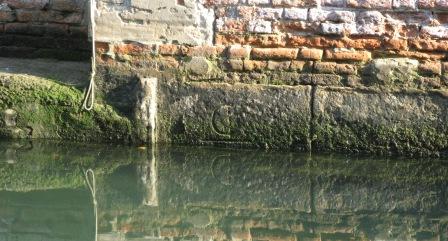
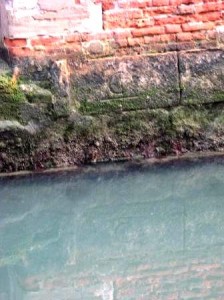
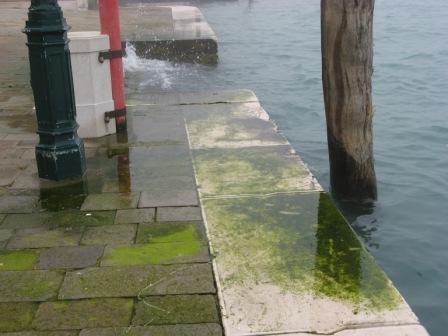
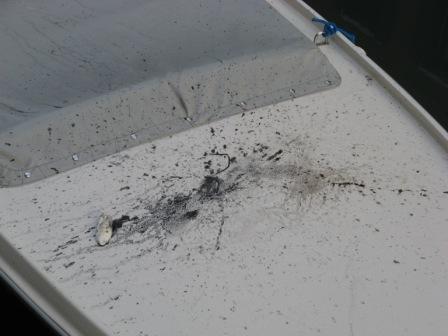 and a battle ensued, which the seppia lost. You can tell by the splashings of desperate black ink. Another clue is the cuttlebone, which if I had a parakeet or Andean condor I would immediately have taken.
and a battle ensued, which the seppia lost. You can tell by the splashings of desperate black ink. Another clue is the cuttlebone, which if I had a parakeet or Andean condor I would immediately have taken. 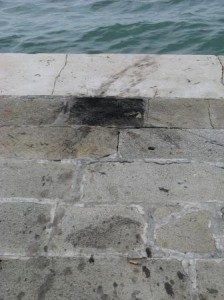 Many of them indicate epic battles, all futile.
Many of them indicate epic battles, all futile.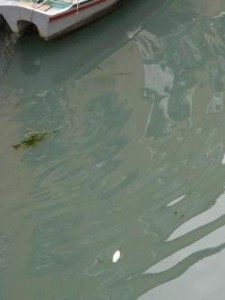
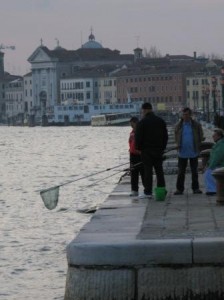 They often go out at night, too, depending on the tides, rigging up a strong light to attract the animals. Or they use a fish-like lure. Lino once slew a vast number of them by hooking a medium-length remnant of a white plastic bag to his line and pulling it slowly through the water; despite the fact that seppie have some of the most developed eyes in the animal kingdom, it somehow looked irresistibly like another seppia. They don’t eat only crabs, shrimp, worms, or whatever — they snack on each other, as well. Too much information?
They often go out at night, too, depending on the tides, rigging up a strong light to attract the animals. Or they use a fish-like lure. Lino once slew a vast number of them by hooking a medium-length remnant of a white plastic bag to his line and pulling it slowly through the water; despite the fact that seppie have some of the most developed eyes in the animal kingdom, it somehow looked irresistibly like another seppia. They don’t eat only crabs, shrimp, worms, or whatever — they snack on each other, as well. Too much information?  One more thing: It may not be very likely that you’ll be buying seppie in the fishmarket, but if you are looking at them for whatever reason, you should know that the whiter they are (it’s more like a ghastly gray mortuary pallor), and the more smeared with sticky black ink, the older they are. Lots of ink is a Bad Sign.
One more thing: It may not be very likely that you’ll be buying seppie in the fishmarket, but if you are looking at them for whatever reason, you should know that the whiter they are (it’s more like a ghastly gray mortuary pallor), and the more smeared with sticky black ink, the older they are. Lots of ink is a Bad Sign. 